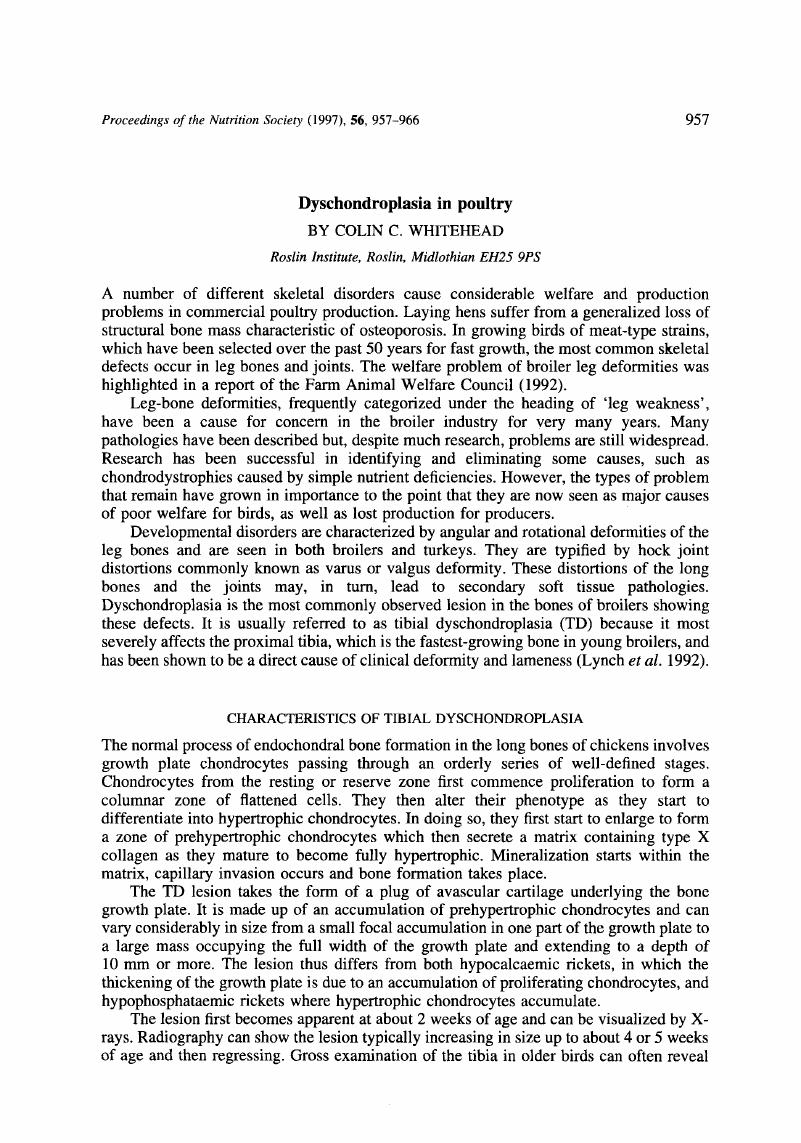Crossref Citations
This article has been cited by the following publications. This list is generated based on data provided by Crossref.
Jefferies, D
Houston, B
Lester, D
Whitehead, C.C
Thorp, B.H
Botman, M
and
Farquharson, C
2000.
Expression patterns of chondrocyte genes cloned by differential display in tibial dyschondroplasia.
Biochimica et Biophysica Acta (BBA) - Molecular Basis of Disease,
Vol. 1501,
Issue. 2-3,
p.
180.
Farquharson, C.
and
Jefferies, D.
2000.
Chondrocytes and Longitudinal Bone Growth: The Development of Tibial Dyschondroplasia.
Poultry Science,
Vol. 79,
Issue. 7,
p.
994.
Li, J.
Bi, D.
Pan, S.
and
Zhang, Y.
2007.
Effect of diet with thiram on liver antioxidant capacity and tibial dyschondroplasia in broilers.
British Poultry Science,
Vol. 48,
Issue. 6,
p.
724.
Tian, W. X.
Zhang, W. P.
Li, J. K.
Bi, D. R.
Guo, D. Z.
Pan, S. Y.
Zhang, Y. H.
and
Qin, P.
2009.
Identification of differentially expressed genes in the growth plate of broiler chickens with thiram-induced tibial dyschondroplasia.
Avian Pathology,
Vol. 38,
Issue. 2,
p.
161.
Fothergill, Brooklynne “Tyr”
Thomas, Richard
and
Morris, James
2012.
Avian tibial dyschondroplasia in 19th-century turkey (Meleagris gallopavo L. 1758) remains from the Royal London Hospital.
International Journal of Paleopathology,
Vol. 2,
Issue. 4,
p.
240.
Crespo, Rocio
and
Shivaprasad, H.L.
2013.
Diseases of Poultry.
p.
1233.
Bachmann, H.
Autzen, S.
Frey, U.
Wehr, U.
Rambeck, W.
McCormack, H.
and
Whitehead, C.C.
2013.
The efficacy of a standardised product from dried leaves ofSolanum glaucophyllumas source of 1,25-dihydroxycholecalciferol for poultry.
British Poultry Science,
Vol. 54,
Issue. 5,
p.
642.
Wójcik, E.
Andraszek, K.
Ciszewska, M.
and
Smalec, E.
2013.
Sister chromatid exchange as an index of chromosome instability in chondrodystrophic chickens (Gallus domesticus).
Poultry Science,
Vol. 92,
Issue. 1,
p.
84.
Muir, William M.
and
Cheng, Heng Wei
2014.
Genetics and the Behavior of Domestic Animals.
p.
317.
Muir, William M.
and
Cheng, Heng Wei
2014.
Genetics and the Behavior of Domestic Animals.
p.
463.
Van der Veen, Gerjan
Fosgate, Geoffrey T.
Botha, Frederick K.
Meissner, Heinz H.
Jacobs, Lubbe
and
Prozesky, Leon
2017.
Response of cattle with clinical osteochondrosis to mineral supplementation.
Onderstepoort Journal of Veterinary Research,
Vol. 84,
Issue. 1,
Scholey, D. V.
Belton, D. J.
Burton, E. J.
and
Perry, C. C.
2018.
Bioavailability of a novel form of silicon supplement.
Scientific Reports,
Vol. 8,
Issue. 1,
Crespo, Rocio
2020.
Diseases of Poultry.
p.
1286.
Li, Jianzeng
Liu, Xinxin
Cai, Chunxia
Zhang, Lujie
An, Zhiyuan
Guo, Yujie
Zhang, Yanhua
Li, Wenting
Sun, Guirong
Li, Guoxi
Kang, Xiangtao
and
Han, Ruili
2024.
Plasma exosome-derived miR-455-5p targets RPS6KB1 to regulate cartilage homeostasis in valgus-varus deformity (Gallus gallus).
Poultry Science,
Vol. 103,
Issue. 11,
p.
104169.



